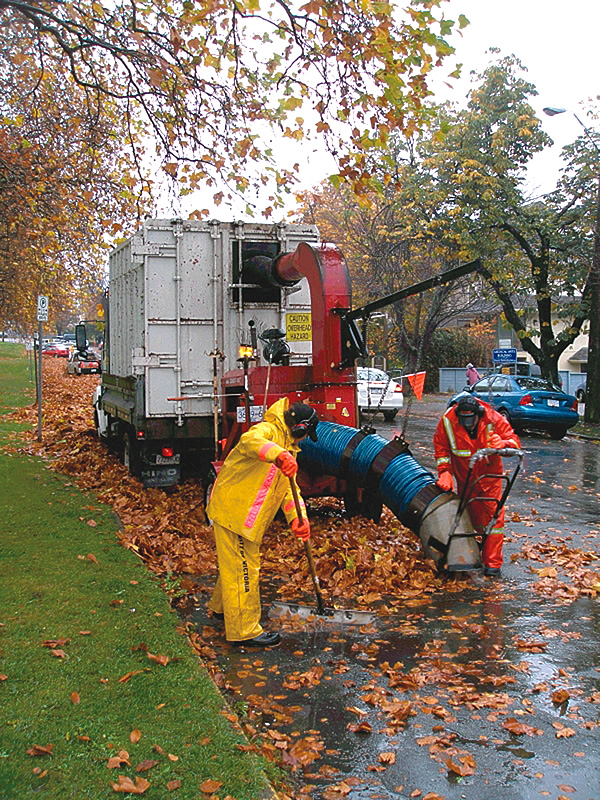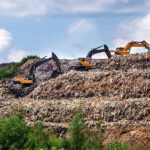The City Parks Division has taken steps to reduce the carbon footprint of its annual leaf collection as well as expanded applications for finished compost and leaf mulch.
Ken Hilchey
BioCycle October 2014
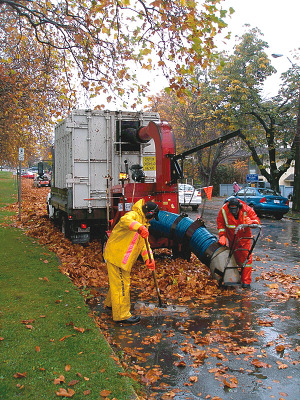
The Residential Leaf Pick-Up Program takes place over four months, starting in October when trees first drop their leaves. Photo courtesy of the City of Victoria Parks Division
The City of Victoria, located on the southern tip of Vancouver Island and capital city of the province of British Columbia, is known internationally as the City of Gardens. With a population of 83,000 residents, the city has held this distinction partly because of its mild winter climate compared to the rest of Canada. However, this status is mainly due to the year round garden displays, the urban forest, Beacon Hill Park, and the world famous summer hanging baskets. The caretaker of the 465 acres of green spaces, 125,000 annual and perennial plants and 77 year-old hanging basket program is the City of Victoria’s Parks Division. Along with all these responsibilities is the urban tree population that the division manages.
The leaves these trees provide have been a huge part of the City of Victoria Parks Division history. For more than 40 years, it has been recycling leaves and wood chips seasonally. Through its Residential Leaf Pick-Up and Branch Chipping programs, the Division collects approximately 9,150 cubic yards (cy) of dry leaves and 1,300 cy of wood chips annually. Green waste, including annuals, sod and grass clippings (no noxious weeds), also are composted.
The City of Victoria has always used the by-products of these composting programs in its gardens, chip paths and soil mixes. However, the city is just beginning to utilize them more widely on its green spaces, such as sports fields, and has been providing local community gardens and homeowners with leaf mulch.
Currently, 40,000 trees line streets and parks in Victoria. Deciduous trees account for 94 percent of the trees. They start dropping their leaves in October and continue until sometime in mid-November. From that point, through to the following January, the Parks division is tasked with collecting all the leaves and finding storage/composting area. In addition, City staff picks up leaves from another estimated 110,000 trees on residential properties.
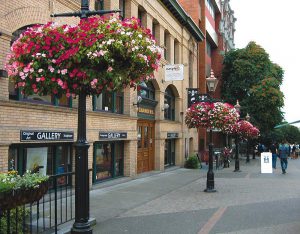
Victoria is famous for its summer hanging baskets, a 77-year old program. Photo courtesy of the City of Victoria Parks Division
Collected leaves are taken to the City of Victoria Parks Yard Dump — now referred to as the Recycling Compound — a 4,500 square yard composting facility. For many years, the leaves were stockpiled, and harvested as leaf mulch the following year. Five years ago, Ron Webster, a city Parks employee, completed a Compost Facility Operator training and converted the site into a composting and soil production center. Through his own innovation and experimentation, Webster continually tries new mixes and blends of the leaf mulch, compost and soil to get the best growing medium for annuals, perennials, plantings and grass.
Reducing Pesticide Use
Historically, benefits of annual leaf collection include production and use of compost, maintaining the aesthetics of streets, parks and lawns, and keeping the road gutters clear during the time of year Victoria receives the most precipitation. In the past few years, however, collection of leaves has provided a fourth added benefit to the Parks division. “The native Douglas fir forests in the manicured areas of the park (Beacon Hill Park) have all been converted from turf to a mix of leaf and bark mulch then planted with native plants,” explains Steve Curry, Supervisor of Horticulture. “This new forest floor mimics the natural forest and still allows park users to walk freely among the majestic fir trees. At the same time, it promotes the health of these large trees, minimizing ground compaction, providing a natural fertilizer, and improving drainage of the areas.”

Ron Webster, a city Parks employee, is a certified composting facility operator who manages the site and prepares mixes and blends of the leaf mulch, compost and soil to optimize the growing medium for Parks Department plantings. Photo courtesy of the City of Victoria Parks Division
The need for making this change arose as a result of the City’s Pesticide Use Reduction Bylaw, which has restricted the parks use of chemical treatment for weed control. “This (mulching) program greatly reduces the weeding required in the mulched areas,” adds Curry. Presently, the Horticulture section of the Parks Division uses approximately 800 cy of mulch biannually on the ferneries in Beacon Hill Park and another 800 cy of a 50:50 mixture of leaf/ bark mulch for “other horticultural areas within the city such as shrub beds and medians,” he says.
New Initiatives
The Residential Leaf Pick-Up Program is a huge undertaking as up to 26 staff are dedicated to the program for four months. There is also the noise factor from blowers, mowers equipped with blades, heavy duty trucks and vacuums (aka leaf suckers) that all run on diesel and send the decibel readings off the charts at times. While the benefits of the end leaf product are valued, the means in which to collect them is not very carbon neutral. As a result, the Parks Division’s staff are trying a new approach, working with neighborhood associations and encouraging residents to work together on weekends to pile leaves together. This way, one huge pile is picked up, in a shorter period of time, versus vacuuming up countless smaller piles of leaves along city blocks. Other initiatives include: promoting Victoria residents to drop off their leaves at the City of Victoria Public Works yard for free, and scheduling leaf pick up when all the leaves have dropped and residents have been given sufficient time to gather them for collection.
In 2012, the City introduced a new program that encourages residents to try bagging their leaves in compostable bags for pick up. The Parks Division has committed one truck to this service and residents who opt in are promised pick up within a five day window. Through trials and experiments conducted at the Recycling Compound, it was proven that compostable bags meeting ASTM #D6400, filled with leaves and mixed in with the existing leaves collected, break down quickly in the hot steamy center core of the pile. No plastic residues were detected. “Due to the volume of the material collected in a condensed period of time, we are able to consistently generate elevated high temperatures in the pile that encourage the rapid breakdown of light material contained in the collected organic matter,” explains Gord Smith, Manager of Parks Operation. “Monitoring moisture, aeration and the carbon:nitrogen ratio is also important to aid in the efficient product turnover.” For the 2013/14 Residential Leaf Pick-Up Program, the City began selling compostable bags at a reduced cost.
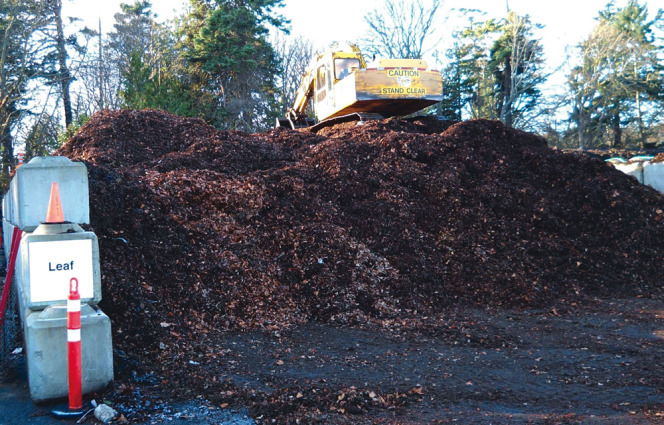
The Recycling Compound processes all collected leaves — close to 10,000 cubic yards/year — along with wood chips and green waste. Photo courtesy of the City of Victoria Parks Division
Today, the City of Victoria is using more of the leaf mulch in its parks and gardens around town. A portion is shared with other municipalities and given to local community gardens. “In the near future, the hope is we can start selling a blend of leaf mulch and compost, which would offset some of the operating costs and burden on the taxpayers,” the Parks Division reports. Through continued public awareness and education such as the City-sponsored “Compost Day,” more people will understand and reap the benefits of composting their own leaves.
This initiative is aligned with the City of Victoria’s goal as a community to reduce its greenhouse gas levels. “Victoria has a community greenhouse gas reduction target of 33 percent by 2020 based on 2007 levels,” notes Allison Ashcroft, Senior Planner-Environmental Issues for the city. “In 2010, landfill gas (methane) accounted for 11 percent of our community’s emissions.” The City is working to increase its landfill diversion rate and is targeting organics, which comprise 30 percent of waste disposed. In 2013, almost 2,000 tons of household kitchen scraps were diverted in the city’s first year of operating a dual stream solid waste collection program. (The material was sent to an anaerobic digester in Vancouver.) “The ongoing annual leaf pick up program also keeps another over 550 tons of yard waste from ending up at the landfill, thereby avoiding harmful greenhouse gases from being generated,” adds Ashcroft. “Combined, these two programs reduce our community’s carbon footprint by nearly 1,800 metric tons of carbon dioxide equivalent annually.”
While Victoria’s inventoried street trees are providing a protective summer shade canopy over the city, keeping residents cool and absorbing carbon emissions, the resulting beneficial by-product, the fallen leaf, is producing gold for the city’s parks and gardens.
Ken Hilchey is Supervisor of Operations for the City of Victoria, Parks Division, British Columbia.


